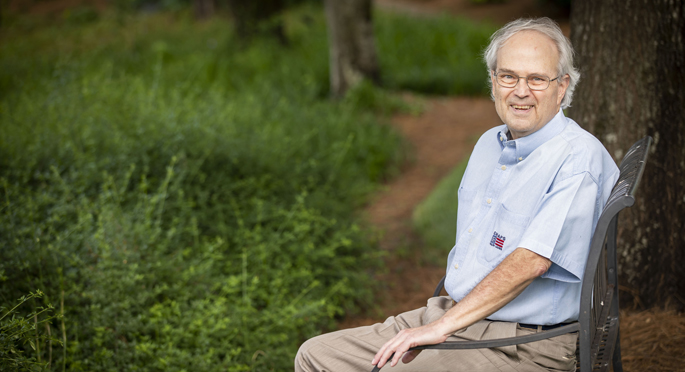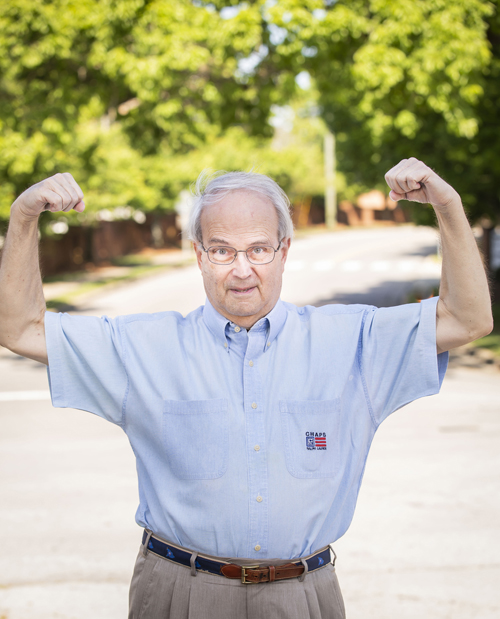
On March 27, Nashville resident Bill Boyce, 73, earned the unwelcome distinction of becoming the first patient intubated on Vanderbilt University Medical Center’s dedicated COVID-19 unit.
He spent 28 days under the vigilant care of the inpatient COVID-19 team, ultimately recovering to be discharged to home on April 24. He credits a broad network of care at VUMC, a continuum of watchfulness that extended both before and after his hospitalization, for saving his life.
“Honestly, I didn’t know how sick I was until I woke up, and I discovered I had wires and tubes in places I didn’t know I had places,” Boyce said. “I was on a ventilator, but I have no memory of that. Vanderbilt took this seriously, and I’m still here, bad jokes and all.”
Boyce was in the first wave of COVID-19 patients at VUMC, when clinicians were learning daily about the virus and its progression.
In the pandemic’s early weeks, a plan was put in place at the Medical Center to ensure anyone who tested positive for the novel coronavirus at any site across the VUMC network would have some form of follow-up monitoring.
The VUMC COVID-to-Home program, which became a part of Boyce’s care after his positive test result, includes three levels of care: care coordination, telemedicine support and hospital-to-home support, ensuring close oversight of these individuals.
Once an individual’s positive test result is entered into an electronic patient registry, a team of care coordinators and clinicians call that individual for an initial check in.
If a patient already has a primary care provider, the team contacts that provider and that physician’s office typically takes over their follow-up monitoring and care.
Since mid-March, more than 1,500 patients have been monitored by phone by the VUMC COVID-19 Care Coordination team for 14 days following their positive test to track symptoms and ensure they are progressing toward recovery.
In addition, the COVID-to-Home program, a joint program staffed by Vanderbilt Health OnCall and Vanderbilt Home Care Services (VHCS) clinicians, has served more than 100 patients with frequent in-home nursing visits, close involvement by nurse practitioners and regular phone calls to assess symptoms and vital signs.
When Boyce initially began having flu-like symptoms in mid-March, he got a COVID-19 test at the Vanderbilt Walk-In Clinic in Bellevue.
Boyce’s physician at Vanderbilt Primary Care North One Hundred Oaks, Tiffany Hines, MD, received notification that he had tested positive for the virus. Boyce had just completed radiation therapy for prostate cancer, and his age also put him at greater risk, so Hines was very concerned.
As soon as his positive result was received, Hines and her team, as well as the VUMC Care Coordination COVID-19 team led by Julie Scott, RN, began providing telehealth follow-up phone calls as he quarantined at home.
Despite Boyce’s continual insistence that he “was just fine,” his family, who was also checking on him through phone calls for their safety, and Hines weren’t convinced. His sister Nell Smith even hired a private ambulance crew to take him to the emergency room, but he turned them away.
“I was listening to that awful COVID cough and hearing his shortness of breath, and I knew he wasn’t fine,” said his sister Mary Etta Boyce, a retired emergency room nurse. “When he rolled out in the ambulance, he was on his way to death’s door.”

Due to Boyce’s worsening symptoms, on March 27 Hines requested an in-person visit by a VUMC provider. Mary Walden, MSN, FNP-BC, part of the COVID-to-Home program, made a telehealth phone call to Boyce that same day, and shortly after Melissa Duque, RN, with VHCS visited him at home.
While he still insisted he was fine, his oxygen saturation level in the 70s told a different story. He was raced to the VUMC Emergency Department, and after evaluation he was moved to the COVID Unit to begin his nearly month-long stay.
“Kristin Nguyen, RN, cared for him the night he was intubated and said they had to tell him to quit telling jokes so they could intubate him,” said Neil Stinson, RN, a member of the Communicable Disease Response Team who cared for Boyce. “He has a very dry sense of humor.
“I cared for him the following day. He was the first COVID patient I took care of who was intubated. Without any family presence, caring for someone who is intubated, awake and alone is very challenging. I could not stay in his room the whole time, but I felt that I needed to. He was very uncomfortable. Over the following days, he became sicker and sicker. We all worried that he might not recover,” Stinson said.
Boyce experienced life-threatening cardiac arrhythmias and pneumonia, and Hines followed his condition through his electronic medical record and calls to the COVID unit team. She couldn’t visit in person, and Hines knew the isolation was hard for him. As soon as she could call him to provide encouragement, she did.
One day when he was off the ventilator, Boyce pressed his call button. Paul Cloutier, RN, asked what he needed, and his response was “just five minutes of conversation.” Cloutier was happy to keep him company.
“Bill had a stormy ICU course,” Cloutier said. “Through extended intubation and high doses of vasopressors, I had thought several times he would never make it, but he did.”
As Boyce left the hospital, he told his care team his sister, Mary Etta, was dedicating the Gratitune, “Staying Alive,” to everyone who played a part in his recovery. Gratitunes (www.Gratitunes.com) is a consumer-generated music platform that celebrates and thanks members of the VUMC family, through the power of music, during the COVID-19 pandemic.
Boyce himself chose another song, and as he said his goodbyes he sang, “I’ve had the time of my life, and I owe it all to you.”
Casey Lary, RN, said she will never hear that song without shedding a tear and thinking of him.
“We watched as Bill’s journey went from intubation, to extubation, to sitting in a chair, eating food, moving to the step-down unit, to going home,” she said. “Bill became our floor mascot and a symbol of recovery.”
Tara Horr, MD, who oversees VHCS, is part of the daily huddle that decides what care is most appropriate for patients when they leave the hospital. Unfortunately, Boyce’s COVID-19 tests continued to come back positive well after he was healthy enough for discharge, meaning he could not transfer directly to a rehabilitation facility.
“Fortunately, he had stayed here for so long and had such great care by our physical and occupational therapists, it was felt he could safely return to his home,” Horr said.
Because of the complexity of his case, Boyce was monitored by phone calls once again at home by the COVID-to-Home program.
A complaint of leg pain during one call indicated a possible blood clot – a complication associated with COVID-19. An ultrasound confirmed the diagnosis, and it was successfully treated.
Boyce now says he’s feeling great and getting stronger each day.
“When I left, they gave me a send-off party,” he said. “I was crying and some of the nurses were crying. I’m here today because of Vanderbilt.”
“It’s a blessing he was at Vanderbilt,” agreed his sister, Mary Etta. “The Emergency Room staff, COVID-19 unit, the step-down unit — to a person, everyone I spoke with and interacted with — saved my brother’s life.”












